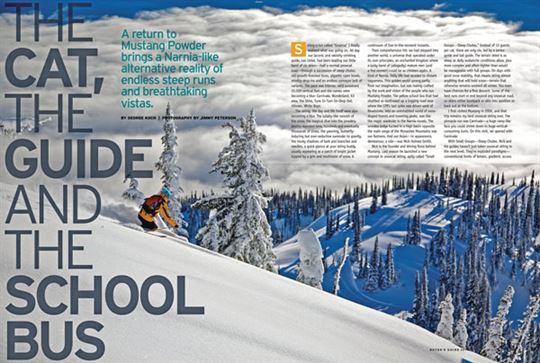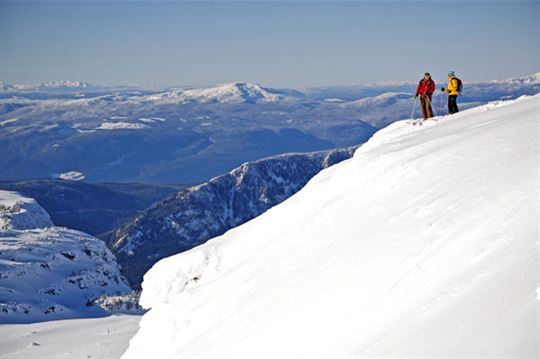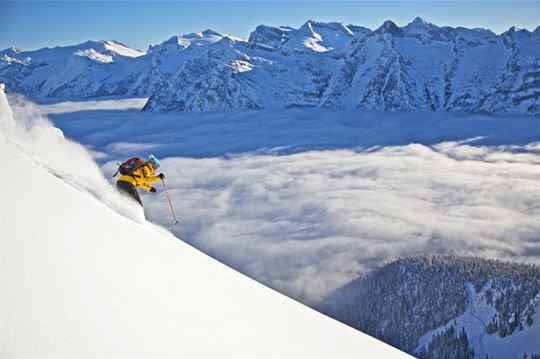The Cat, the Guide and the School Bus
A return to
Mustang Powder
brings a Narnia like
alternative reality of
endless steep runs
and breathtaking
vistas.
by George Koch photos: Jimmy Petterson
Skiing a run called “Gnarnia” I finally
realized what was going on. All day
our laconic and rakishly smirking
guide, Lee Usher, had been leading our little
band of six skiers—half a normal snowcat
load—through a succession of steep chutes,
old-growth-forested faces, gigantic open bowls,
windlip drop-ins and an endless conveyor belt of
variants. The pace was intense, we’d surpassed
20,000 vertical feet and the names were
becoming a blur: Carnivale, Wonderland, K3
area, the Shire, Tune In-Turn On-Drop Out,
Hitman, White Boys.
The skiing, the day and life itself were also
becoming a blur. The lullaby-like swoosh of
the snow, the magical dive into the powdery
depths repeated tens, hundreds and eventually
thousands of times, the yawning, butterfly-inducing
but ever-seductive surrender to gravity,
the murky shadows of bark and branches and
needles, a quick glance at your skiing buddy,
usually appearing as a patch of bright jacket
topped by a grin and mushroom of snow. A
continuum of live-in-the-moment instants.
Then comprehension hit: we had stepped into
another world, a universe that operated under
its own principles, an enchanted kingdom where
a lucky band of (allegedly) mature men (and
a few women) could be as children again. A
kind of Narnia. Daily life had receded to distant
vagueness. This golden world sprang partly
from our imagination, but was mainly crafted
by the work and vision of the people who run
Mustang Powder. The yellow school bus that had
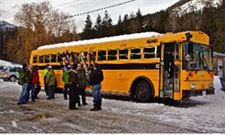 shuttled us northward up a logging road near where the CPR’s last spike was driven west of Revelstoke, into an uninhabited world of snow-draped forests and towering peaks, was like the magic wardrobe in the Narnia novels. The wooden lodge tucked in a high basin opposite the main range of the Monashee Mountains was our fastness. And our Aslan—in appearance, demeanour, a role—was Nick Holmes-Smith.
shuttled us northward up a logging road near where the CPR’s last spike was driven west of Revelstoke, into an uninhabited world of snow-draped forests and towering peaks, was like the magic wardrobe in the Narnia novels. The wooden lodge tucked in a high basin opposite the main range of the Monashee Mountains was our fastness. And our Aslan—in appearance, demeanour, a role—was Nick Holmes-Smith.
Nick is the founder and driving force behind Mustang. Last season he launched a new concept in snowcat skiing, aptly called “Small Groups—Steep Chutes.” Instead of 12 guests per cat, there are only six, led by a senior guide and tail guide. The terrain skied is as steep as daily avalanche conditions allow, plus more complex and often tighter than would be manageable with full groups. On days with good snow stability, that means skiing almost anything that will hold snow—terrain that otherwise remains unskied all winter. You even have chances for a first descent. Some of the best runs start or end beyond any snowcat road, so skiers either bootpack or skin into position or back out at the bottom.
I first visited Mustang in 2006, and that trip remains my best snowcat skiing ever. The pinnacle run was Carnivale—a huge ramp-like face you could shriek down in huge vertical-consuming turns. On this visit, we opened with Carnivale.
With Small Groups—Steep Chutes, Nick and his guides haven’t just taken snowcat skiing to the next level. They’ve exploded paradigms— conventional limits of terrain, gradient, access and daily vertical—and created a new genre. No surprise that the originator is Nick, highly competitive (though warm and welcoming) personality who continually pushes for the best, a legacy of his past as an Olympic-level three- day-event equestrian who medalled in the Pan- Am Games.
Our particular Small Group comprised three thirty-something, friendly, eager —and slim!—— Chicagoans named Tom, Ryan and Sean, venerable nternational ski hotographer Jimmy Petterson, is extremely blond son Erik, and me. All of us were veterans in one way or another, yet we all sheepishly confessed that Mustang’s dire warnings plus the vertiginous website terrain photos had us wondering if we were good enough. It was not a problem. Although Lee mentioned a couple of previous guests had suffered significant emotional events in the “sportier ” routes, everyone in our group was well-suited.
We all loved Lee’s guiding approach, which rested on a kind of laconic reverse psychology. He’d often start a run with something along the lines of, “You might need to huck in at the top, or in the middle, or at the bottom,” or, “I think this goes through, but there might be cliffs. We could try it.” Quite opposed to typical mountain guide’s instruction, “You MUST stay to the left of my track,” which always triggers a little boy’s curiosity about what’s on the right.
At Mustang, the only sane place to spend the period before sundown is the outdoor hot tub. The first evening in Narnia brought one of the most sublime mountain scenes I’ve witnessed. The bitingly cold air was so dry airliners racing overhead weren’t even leaving contrails. Over about 90 minutes, the main spine of the Monashees across the valley —glaciated, cliffy, with huge rippling slopes and 4,000-vertical- foot couloirs spilling off the peaks—shifted through a dozen gorgeous shades: pale yellow through honey yellow, pale tangerine, deep orange and finally lavender.
Dinner as a sybaritic pairing of successive wines with Caesar salad and prawns, spicy lamb, salmon and beef striploin. I had a delightfully improbable reunion with exactly the crew of Calgary businessmen I’d skied with in 2006— Dave, Warren, Art, Dunnery, Neil and others. It was the same tour in February, and they were once again filling a regular cat. Ski Canada subscribers and global warming skeptics to a man, they ribbed me about the storm of letters to the editor my recent Climategate column had triggered. “So why didn’t you write in?” I asked. Dave replied smiling, “It was way more fun to watch you twist in he wind.
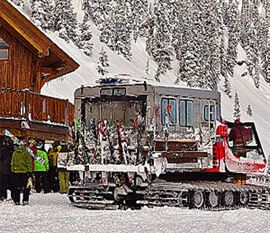 They were also clearly in Narnia. The day’s triumph had been descending Fifth Dimension, a 1,400-vertical-metre, rolling northeast face of multiple pitches, ending far below treeline near the end of Mustang’s massive tenure, requiring a second snowcat to effect the pickup. Said Warren, “I’ve snowcat skied probably 80 days and that was unquestionably the best cat-skiing of my life.”
They were also clearly in Narnia. The day’s triumph had been descending Fifth Dimension, a 1,400-vertical-metre, rolling northeast face of multiple pitches, ending far below treeline near the end of Mustang’s massive tenure, requiring a second snowcat to effect the pickup. Said Warren, “I’ve snowcat skied probably 80 days and that was unquestionably the best cat-skiing of my life.”
The next day dawned ice cold and crystal clear, surface hoar glimmering like uncountable diamonds. After an enormous breakfast, Mustang’s huge cats lurched off with the timing of Swiss trains. The day became a lesson, if any were needed, of the Small Groups program’s freedom. Lee roamed restlessly around Mustang’s vast terrain, delivering run after run of genuine pinnacle skiing, entrances pitched at 45 degrees and sustained pitches of 40 or better. We were almost continually beneath, beside, opposite or atop massive rugged terrain features, making the experience less like standard snowcat skiing than heli-skiing or off-piste touring in the Alps.
At Centurion Ridge we skied carefully down a steep pongee-strewn rollaway, then shot out into a broad bowl arcing big turns to a tiny
frozen lake. With no cat roads in this valley, we skinned briefly to a gentle saddle, then skied another chute into developed terrain. Following this came the even steeper Centaurus Chutes. Starting with a short bootpack onto a rocky ridge ringed by cliffs, a careful sliding traverse across a major avalanche start zone took us across a spine to a long 45-degree slope. It must have run for 250 vertical metres before benching, then rolled again into an ancient burn of standing dead timber. Stunning. The Chicago boys skied manfully, fast and bouncy as if they’d dined on rabbit stew the night before.
Possibly the finest run was Serpent in the Rainbow. I’ll start at the end. The last pitch was an enormous run-out that went and went for what had to be 400 vertical metres and that, given what we’d already done, seemed virtually fl at. Looking back from the bottom I realized it had to be 30 degrees. If that seemed flat, what had we just done? The middle pitch had been a mini-cirque under enormous black ramparts looking as if they were ready to topple. Yet that had been far mellower than the opening couloir. In settled powder, nothing really feels steep until it’s 45 degrees. This chute definitely did. Feel steep.
During multiple cat rides, the Chicago boys had been chanting “Shot Ski,” so at day’s end I broke my ironclad middle-aged rule of avoiding drunken buffoonery. Like the Small Groups program, Shot Ski precisely describes the experience. The chosen beverage was iced Jägermeister. With the four of us draining our conjoined glasses without spilling a drop, Tom commented, “You know, I feel our team is really starting to jell.”
On the fourth day I awoke to a somewhat unsettled feeling. There seemed an ominous but undefined ripple in the Narnia firmament. I cast it aside as we loaded up the cat. The ride to the southerly reaches made it clear how much terrain—entire mountainsides—the regular groups pass by. Today, we’d be exploring some of that in the K3 area. A half-hour ascent on skins along a steep ridgetop brought us into position: a mid-40-degree, treed and somewhat rocky face randomly strewn with miniature gullies and other terrain featurettes. “Boys, this face has never been skied, and it has no name,” Lee announced.
The Chicago team was dialled. Their attitude had quickly migrated from, “I’m not sure I can do this,” to, “Is that all you got?” They were jostling to see who could enter first and get the best personal mini-couloir. Sean, the most modest about his abilities, had come on the strongest, and it was a joy to see. Ryan and Tom bobbed through the narrow bits, then swooped at film-team speed across the open pitches. The mini-gullies spilled into a huge bowl and then rolled into further treed pitches. At the bottom, discussion ensued, and we settled on “Red Dawn” to name the descent—both for its chaotic character and its aspect facing the rising sun.
We worked our way back toward the lodge via a series of great treed runs all still with virtually blower powder. The weak, formless dread I’d felt in the morning was intensifying. The skiing was wondrous but felt bittersweet. Narnia was crumbling; we all felt it. Within a couple of hours we’d have to board the yellow school bus and step back through the magic wardrobe. Little boys would revert to grimly purposeful men. Down in the valley, as we transferred our gear from snowcats to the school bus, the incoming groups were milling around in a blinding fall of huge snowflakes. They were giggling and joking, wearing the expressions of children. They already had one foot in the wardrobe. ❄
The Keys to the Magic Wardrobe
GETTING THERE:
Access via the meeting point at
the Skyline Esso in Malakwa on the
Trans-Canada Highway about a half
hour west of Revelstoke. Transfer to
lodge (about two hours) via school
bus and snowcat. Nearest airport:
Kelowna, then a two-hour drive to
the meeting point.
SEASON:
December 2 through April 9.
LODGING:
All guests stay in the luxurious and
fully equipped timber-frame lodge
(there’s no day-skiing). Wireless
Internet network. Satellite telephone
available to guests ($1/minute); no
cellular coverage or landline.
CAPACITY:
30 guests (two regular groups of
12, one Small Groups—Steep
Chutes group of six), three operating
snowcats. Mustang has late-model,
powerful Pisten Bully snowcats.
PACKAGES:
Three- and four-day (plus one fi ve-day)
packages available, with prices
of $600 (low season) to $900 (high
season) per day, plus HST, all-inclusive
except ski rentals, alcohol
and gratuity. Small Groups—Steep
Chutes runs January 10 through
April 9 at $750-$950 per day. Skis
with touring bindings, climbing
skins and avy-packs are available
for rent.
MORE INFO:
www.mustangpowder.com
